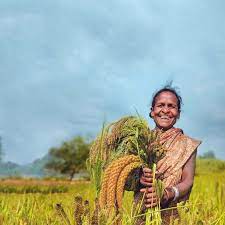Odisha Millets Mission (OMM) was started by the Odisha government in 2017 to revitalize millets in farms and on plates for a five-year period. It was renewed until 2026-27 by the Odisha Cabinet in 2022. Odisha has 62 tribal communities. Tribal cultures have a long history of preserving indigenous millets. Odisha’s tribal farmers have been guardians of many millet types since time immemorial.
These historic types have adapted to their surroundings. Some of them are more resistant to pests and climate change. These historic landraces frequently outperform in organic agricultural circumstances. Several such historic landraces are in high demand, but are difficult to obtain for farmers.
However, because to a lack of conventional scientific operating methods, the government has been unable to provide enough support to the custodian farmers and indigenous people that have protected this treasure. This has resulted in the extinction of biodiversity and the loss of indigenous communities’ traditional legacy.
For the first time in the country, the Department of Agriculture and Farmers’ Empowerment created a standard operating procedure for recognizing, evaluating, and releasing traditional landraces through the OMM seed system. This system was also created with the help of ICAR, OUAT, technical specialists, field NGO partners, and, most crucially, custodian tribal farmers. During the development, criteria like as flavor, climatic resilience, pest tolerance, cultural preference, and others were considered in addition to typical scientific characteristics such as yield.
Documentation of landraces was conducted as part of the process, as was conservation in farmer fields, mapping of farmer preferences, formulation of seed standards from a farmer’s perspective, and so on. Participatory varietal trials of traditional landraces and improved cultivars were also conducted. This technique resulted in the identification of 163 millet landraces. 14 landraces have demonstrated exceptional promise. Four landraces are being examined for release under the Seed system for landraces: Kundra Bati, Laxmipur Kalia, Malyabanta Mami, and Gupteshwar Bharati.
Dr Arabinda Kumar Padhee, Principal Secretary, Department of Agriculture & Farmers’ Empowerment said that “Government of Odisha has now formally approved the formation of the landrace varietal release committee to release traditional millet landraces conserved by tribal custodian farmers. Last 3 years have been spent in doing the rigorous trials to get the necessary scientific data. By combining scientific rigor and traditional wisdom, the seed system for landraces initiative has created paradigm shift in mainstreaming agrobiodiversity.”
The United Nations Food and Agriculture Organization is also eager to collaborate with Odisha on landrace seed systems and transfer these lessons to other countries around the world. The National Rural Livelihood objective has recently written to various state governments, urging them to adopt crop diversity blocks and landrace mapping approaches to their objective. The National Rainfed Area Authority of the Ministry of Agriculture and Farmers’ Welfare of the Government of India is also eager to partner with and learn from the Odisha Millets Mission.







 Finance
Finance







